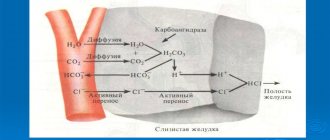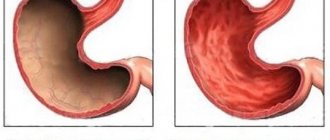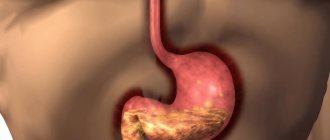What is the gastric mucosa
The mucous membrane of the stomach is formed by a single layer of columnar epithelium, a layer of its own and a muscular plate that forms folds (relief of the mucous membrane), gastric fields and gastric pits, where the excretory ducts of the gastric glands are localized.
The mechanism for protecting the gastric mucosa from the aggression of gastric juice is contributed by the extremely rapid nature of gland secretion due to the work of the muscle fibers of the gastric mucosa
The surface of the gastric mucosa is covered with a continuous thin layer of mucous gel consisting of glycoproteins, and underneath is a layer of bicarbonates adjacent to the superficial epithelium of the mucosa.
The surface of the mucous membrane of the body of the stomach has a pitted structure, which creates conditions for minimal contact of the epithelium with the aggressive intracavitary environment of the stomach, which is also facilitated by a thick layer of mucous gel. Therefore, the acidity on the surface of the epithelium is close to neutral.
The mucous membrane of the body of the stomach is characterized by a relatively short path for the movement of hydrochloric acid from the parietal cells into the lumen of the stomach, since they are located mainly in the upper half of the glands, and the main cells are in the basal part. An important contribution to the mechanism of protecting the gastric mucosa from the aggression of gastric juice is made by the extremely rapid nature of gland secretion, caused by the work of the muscle fibers of the gastric mucosa.
Principles and methods of restoring the gastric mucosa
Treatment of damaged gastric mucosa is always complex, it includes normalizing gastric secretion, creating protection for the mucosa and stimulating recovery processes. Traditional medicine is a good addition.
Regeneration after taking antibiotics
Many people have to take antibiotics for inflammatory diseases. A course of antibacterial therapy is also prescribed for stomach diseases to combat Helicobacter. Along with their beneficial effects, antibiotics have an inhibitory effect on epithelial cells and kill beneficial microflora of the digestive tract.
How can you restore your stomach after such “heavy artillery”? To do this, prescribe a gentle diet, special preparations that heal the gastric mucosa, bacterial agents containing beneficial bifidobacteria, lactobacilli, bacilli ( Linex , Bifidobacterin , Lactobact and analogues). Immunostimulants and vitamin complexes are prescribed to increase the body's protective properties ( Immunal , Derinat , Echinacea and others, vitamins Salgar , Trado , Bion-3 ).
Treatment with diet
The main “building material” for cell restoration is protein, so food should be rich in protein, which is found in meat, fish, eggs, and dairy products. They should be constantly included in the diet, but cooked by boiling or steaming, without spices. Protein should be consumed at least 100 g per day.
Animal fats should be limited, they overload the stomach, they should be replaced with vegetable oils. Carbohydrates also require restrictions - confectionery, flour products that cause fermentation. During the healing period, exclude raw coarse fiber; consume vegetables and fruits stewed or baked. It is necessary to exclude canned food, pickles, marinades, smoked foods, hot seasonings, sauces, alcohol, hot and carbonated drinks, strong coffee and tea.
Preparations for the restoration of gastric epithelium
There are various drugs used to quickly heal the gastric mucosa. Among them, effective tablets are Cytotec and Misoprostol , which increase blood flow, Cymed, containing trace elements zinc and copper, Regesol with sea buckthorn oil and herbal extract.
A course of injections of solcoseryl or Actovegin, prepared from animal blood, aloe or Kalanchoe extract, gives a good stimulating effect. The selection of these drugs should be made by the doctor on an individual basis.
General information about the gastric mucosa in gastritis
Gastritis is a group of diseases whose common feature is inflammation of the gastric mucosa. The stomach is an organ in the form of a muscular sac located in the upper abdomen behind the lower ribs. It serves as a “reservoir” for incoming food and produces juice for its digestion.
Gastritis occurs when there is an imbalance between the effects of hydrochloric acid and mucosal protective factors. This occurs due to various reasons: the presence of bacteria and the toxins they produce, alcohol intake, painkillers. As a result, inflammation of the gastric mucosa develops.
Acute gastritis is a rapidly developing inflammation that resolves within a short period of time. Most often it is caused by infection with the bacterium Helicobacter pylori and is asymptomatic, sometimes becoming chronic.
Gastritis is a group of diseases whose common feature is inflammation of the gastric mucosa
Also a common cause of acute gastritis is the consumption of large amounts of alcohol, abuse of painkillers (aspirin, ibuprofen, etc.).
Chronic gastritis develops gradually. It affects about 80-90% of the adult population. Chronic gastritis is characterized by inflammation of the gastric mucosa at the cellular level, which can only be determined under a microscope. Over time, the mucous membrane becomes thinner (atrophies), as a result of which the production of gastric juice decreases.
There are two main forms of chronic gastritis:
- gastritis caused by the bacterium Helicobacter pylori (95% of all cases of chronic gastritis): once in the stomach, it contributes to the development of chronic inflammation, eventually leading to thinning of the mucosa. However, for most people, the Helicobacter bacteria does not cause any symptoms;
- autoimmune gastritis: its development is associated with autoimmune mechanisms. In this case, the body produces antibodies to its own cells of the gastric mucosa, which leads to their damage. As a result, the production of hydrochloric acid decreases and the gastric mucosa becomes thinner.
In a healthy body, the gastric mucosa produces a protein necessary for the absorption of vitamin B12, which plays an important role in the formation of red blood cells. With a lack of B12, B12 deficiency anemia develops. Autoimmune gastritis develops very slowly and is usually detected in old age.
Inflammation of the gastric mucosa is gastritis
Gastritis (lat. gastritis) is an inflammation of the mucous layer of the stomach, leading to disruption of the functions of this organ. Gastritis is dangerous because if it is not treated correctly or if the mucous membranes of the stomach are damaged by concentrated acids, alkalis or chemicals, the disease can be fatal. In addition, gastritis can be a precursor to oncological processes in the gastrointestinal tract (GIT).
The stomach is the most vulnerable part of the digestive system. At least three complex digestive processes occur in it: mechanical mixing of the food coma, chemical breakdown of food and absorption of nutrients. The most often damaged is the inner wall of the stomach - the mucous membrane, where the production of two mutually exclusive components of digestion occurs - gastric juice and protective mucus.
Gastritis is manifested by inflammation and destruction of the gastric mucosa. The inflammatory reaction in the human body always develops in response to the action of damaging factors on healthy tissue. In the case of gastritis, it can be an infection, chemicals, high or low temperatures.
Hasty eating and poorly chewed food or dry food injure the mucous membrane mechanically. Eating food that is too hot or too cold causes gastritis due to thermal damage to the stomach lining.
Gastritis is manifested by inflammation and destruction of the gastric mucosa
Eating savory foods (mostly spicy and highly salted foods) irritates the stomach lining, similar to the effects of caustic chemicals.
Gastritis is classified according to several indicators - by type, by localization of the inflammatory process, by etiological factor, by endoscopic picture, by morphological changes in the gastric mucosa. All these indicators are very important for diagnosing and choosing treatment for the disease. Depending on the degree of damage and the duration of exposure to irritating factors, acute and chronic gastritis are distinguished.
Acute gastritis is understood as a single and rapid inflammation of the gastric mucosa caused by exposure to damaging factors of various etiologies (drugs, poisons, food contaminated with microorganisms, alcohol, etc.). With proper treatment, acute gastritis (depending on the form) lasts up to 5-7 days, but complete recovery of the stomach occurs much later.
Chronic gastritis is a long-term recurrent inflammation of the gastric mucosa, during which a number of dystrophic changes develop. Gastritis (with the exception of phlegmonous gastritis) does not belong to the group of dangerous diseases. However, gastritis gives rise to dangerous complications.
Atrophy of the gastric mucosa
Atrophy of the gastric mucosa (in medical literature - atrophic gastritis) is a type of chronic gastritis, manifested in progressive pathological changes in the gastric mucosa and death of the glands that produce gastric juice.
It has been scientifically proven that the occurrence of atrophy of the gastric mucosa is influenced by such factors as: constant nervous stress, the consequences of diseases of the endocrine system (diabetes mellitus and thyrotoxicosis), deficiency of vitamin B12 and iron in the body, as well as hypoxia in pulmonary and heart failure.
Focal atrophy of the gastric mucosa
The danger of focal atrophy of the gastric mucosa is hidden in its symptomatic lack of expression until the pathology develops into a more dangerous form and affects the entire area of the gastric mucosa.
Antral focal gastritis is a type of pathology in which there is a loss of glands responsible for the production of hydrochloric acid and pepsin.
The lesions come in different shapes and sizes and are at different stages of the disease. Timely diagnosis allows you to start treatment at an early stage, which gives a positive result.
Atrophy of the gastric antrum mucosa
The antrum is the distal part of the stomach that mixes and grinds food and then slowly pushes it through the pyloric sphincter. During normal operation, the acidity in it is reduced. Antral focal gastritis is a type of pathology in which there is a loss of glands responsible for the production of hydrochloric acid and pepsin. There is a lack of mucus that protects the walls of the stomach from its own acid, and the possibility of inflammation in other parts increases.
An advanced disease carries the threat of becoming chronic and multiplying in the stomach of many bacteria, for which an environment with low acidity is the optimal condition for life. Symptoms worsen and persistent pain occurs. During chronic atrophy of the gastric antrum mucosa, dysbacteriosis, pancreatitis and anemia can develop. In addition, ignoring the disease invariably leads to disruption of the duodenum, and, as a consequence, to the development of duodenitis and peptic ulcers.
Moderate atrophy of the gastric mucosa
Atrophy of the gastric mucosa according to the criterion of severity can be defined as weak, moderate or severe. Mild atrophy is characterized by a slight shortening of the main glands; a moderate increase in the number of accessory glandulocytes is noticeable in them; some parietal glandulocytes are replaced by mucoid ones, but the main ones are generally preserved.
With severe atrophy, extensive fields of sclerosis are noticeable in places where the glands were, a polymorphic cell infiltrate is observed. The remaining glands are short, parietal cells are replaced by mucus-forming cells. Moderate atrophy, as a rule, is an intermediate phenomenon: along with the remaining fundic glands, there are also those that are represented only by accessory cells.
Focal atrophy of the gastric mucosa
Focal atrophy of the gastric mucosa is a pathology that leads to the death of the glands that are responsible for the production of gastric juice. With this type of atrophy, disorders that occur in the mucous membrane are pathologically progressive. The insidiousness of this disease lies in the ability of cells in the affected areas to degenerate into malignant ones. Therefore, experts classify focal atrophy as a precancerous condition. Another name for this pathology is atrophic gastritis of a chronic nature.
Focal atrophy of the gastric mucosa is characterized by the appearance of pathological foci in the connective tissue in place of the dead glands of the inner lining. The lesions have different sizes and shapes; their morphological structure and appearance resemble an atrophic scar on the skin of the face - a pink, flabby area with noticeable borders. Focal atrophy is dangerous because there are often no symptoms during its development.
Focal atrophy of the gastric mucosa is a pathology leading to the death of the glands that are responsible for the production of gastric juice
Focal atrophy of the mucous membrane of the antrum of the stomach is a type of pathological process that is characterized by damage to the distal part of the stomach and the death of the glands responsible for the production of hydrochloric acid and pepsin. As a result, the walls of the stomach begin to become inflamed. With an old course, bacterial damage and the development of ulcers may occur.
Moderate atrophy, which can be mild, severe and moderate. A weak one is characterized by a slight change in the main glands. For moderate, negative measurements are more significant, in addition, the formation of pathological areas is observed. Severe atrophy is characterized by extensive necrotic lesions.
Diet plays a very important role in the treatment of focal atrophic gastritis. The basic principle is gentle, fractional nutrition. It is preferable to steam food. You should not eat food that is too hot or cold, which will injure the walls of the organ.
The main groups of medications used in the treatment of focal atrophic lesions:
- replacement medications: (natural gastric juice) and digestive enzymes (Pangrol, Creon, Mikrazim), which help to fully digest food;
- medications that help the production of hydrochloric acid: for example, thanks to the use of Plantaglucid, the process of gastric secretion is enhanced, inflammatory manifestations and spasms are relieved;
- vitamins in tablet or injection form: prescribed when the level of hemoglobin and serum iron (vitamin B12) decreases. Painkillers such as No-Spa or Buscopan, which are good for eliminating pain and spasms;
- medications that improve the motility of the digestive tract: - Cerucal, Motilium. They help move the food lump through the stomach to the intestines, preventing the development of stagnation.
In advanced cases of the disease and precancerous conditions, therapy through surgical intervention is indicated.
Tips for the prevention and treatment of mucosal atrophy
Postmenopausal women ignore doctors’ recommendations for taking hormonal therapy, many even consider it harmful. You shouldn’t let the disease get worse and put off going to the gynecologist. Taking hormonal medications during menopause, phytoestrogens therapy, and maintaining a healthy lifestyle will help prevent the disease.
Read
Also:
- Treatment of hair loss with folk remedies
- What is cervical erosion
- Treatment of endometriosis with folk remedies
- How to treat fissures and eliminate vaginal dryness
- Causes of vaginal muscle spasms, symptoms and treatment
- Prolapse of female organs, what is it? Causes and symptoms of prolapse of the vaginal walls, treatment methods
Mucosa in atrophic gastritis
Atrophic gastritis is a severe form of chronic gastritis, which often leads to stomach cancer. This disease is characterized by the occurrence of atrophic changes in the gastric mucosa and a decrease in the secretion of gastric juice, as well as a reduction in the number of glands.
The cause of atrophic gastritis has not yet been established by doctors. The mucous membrane of the stomach can be destroyed due to mechanical and chemical damage, from poor nutrition, from the abuse of spicy, salty and sour, fibrous foods, as well as from the presence of the Helicobacter pylori bacterium. Both men and women are susceptible to this disease.
At the initial stage of the disease, the symptoms of atrophic gastritis are similar to those of gastritis with low acidity. The process of cell destruction begins in the body and at the bottom of the stomach, which contains cells that produce hydrochloric acid and enzymes involved in digestion, as well as the protein necessary for the stomach to absorb vitamin B12.
Atrophic gastritis is a severe form of chronic gastritis that often leads to stomach cancer
Therefore, the first symptoms may appear as B12 deficiency anemia, which often causes misdiagnosis. Painful sensations are practically not manifested; the patient is bothered by heaviness in the stomach after eating, a feeling of fullness in the stomach.
During the development of atrophic gastritis, symptoms such as belching with air after eating, which over time acquires a bitter taste, may appear; heartburn, dry mouth, rumbling stomach, intestinal upset, constipation and diarrhea. The patient's general condition worsens: appetite decreases, the person quickly loses weight, weakness and dizziness often occur after eating. You may experience shortness of breath and stabbing pain in the chest area.
Atrophic gastritis can have varying degrees and locations of damage to the gastric mucosa and is divided into several types:
- diffuse atrophic gastritis;
- atrophic antaral gastritis;
- diffuse gastritis;
- hyperplastic atrophic gastritis;
- atopic focal atrophic gastritis.
Development of atrophy of the gastric mucosa during gastritis
Atrophy of the gastric mucosa or atrophic gastritis is one of the forms of chronic gastritis, which occurs due to the death of some of the cells of the mucosa and the replacement of the glands that produce enzymes and gastric juice with ordinary connective tissue. As a result, the process of digesting food and absorbing nutrients is disrupted, which negatively affects the entire body.
Mucosal atrophy can be either focal or cover the entire stomach. Typically, the disease begins with a focal form, in which separate affected areas are observed, of various sizes and at different stages of the disease. This form of the disease often does not have pronounced symptoms, and may not manifest itself until it develops into a more dangerous form and affects most or all of the mucous membrane.
It is customary to consider separately the atrophy of the gastric antrum mucosa. This section of the stomach, located in its upper part, is responsible for grinding food and further pushing it through the pyloric sphincter.
Mucosal atrophy can be either focal or cover the entire stomach
The acidity in this part of the stomach is usually low, and the glands produce mucus designed to neutralize the effect of hydrochloric acid on the stomach. As a result of mucosal atrophy, the stomach’s protection from the acid it produces is reduced, which increases the likelihood of damage and inflammation not only of the antrum, but also of other parts.
Treatment of atrophy of the gastric mucosa
If the disease is bacterial, antibiotics may be prescribed. Depending on the acidity of the gastric environment, drugs can be prescribed that reduce or increase the production of hydrochloric acid, and almost always - substitutes for gastric enzymes: Pancreatin; Festal; Panzinorm.
Vitamin complexes are also prescribed, primarily B12, since its absorption is the first to suffer. It is worth remembering that in advanced cases, if left untreated, atrophy of the gastric mucosa can lead to cancer. For such a disease, the diet should be as gentle as possible, consisting of easily digestible foods that do not injure or create excessive stress on the diseased organ.
Structure and functions of the mucous membrane
The mucous membrane consists of 3 layers:
- columnar epithelium;
- own record;
- muscle plate.
The columnar epithelium layer produces mucus, which covers the entire surface in a continuous layer 0.5 mm thick, as well as bicarbonate, which neutralizes hydrochloric acid when overproduced.
The lamina propria is the thickest and consists of several types of glandular epithelium that produces hydrochloric acid, the enzyme pepsin, lipase, and biologically active hormone-like substances. The number of gastric glands is about 40 million; they produce up to 3 liters of gastric juice per day. All glands are surrounded by loose connective tissue; small vessels and nerves pass through it; at this level, some substances are absorbed into the blood.
The muscular plate is the deepest, represented by thin smooth muscle fibers; due to their contraction, the surface of the shell has a pitted-folded relief. This structure allows you to increase the area several times, which for an adult is 1-1.5 m2.
Thanks to the listed structures, the mucous membrane performs the following functions:
- Primary protein processing is coagulation with hydrochloric acid and primary digestion with the enzyme pepsin.
- Partial breakdown of fats by lipase.
- Protection against pathogenic bacteria - under the influence of hydrochloric acid.
- Activation of metabolic processes due to the secretion of the hormones gastrin, serotonin, histamine.
- Partial absorption of certain substances into the blood (water, sugar, alcohol, sodium chloride).
Prevention and prognosis of atrophy of the gastric mucosa
The main measure to prevent atrophy of the gastric mucosa is timely treatment of gastritis caused by Helicobacter pylori infection. A healthy diet plays an important role in prevention, because by following its principles, you can significantly reduce the risk of atrophy of the gastric mucosa and its oncological consequences.
Continuous monitoring of patients with chronic gastritis is of fundamental importance: clinical observation and endoscopic examination at least twice a year with histological evaluation of pieces of mucosa taken during biopsy. Chronic atrophic gastritis in modern medicine is recognized as a precancerous disease due to possible complications due to malignancy processes.
The greatest danger comes from the consequences of a violation of the acid-forming function of the patient’s stomach, because this reduces the antitumor protection of the mucous membrane, creating optimal conditions for the harmful effects of carcinogens. Only timely diagnosis and treatment with effective methods for atrophy of the gastric mucosa provide a favorable prognosis and prevent the development of oncological changes.
Sources:
- https://grmn.ru/news/gastrit.html
- https://gastritinform.ru/fb.ru/article/406480/ochagovaya-atrofiya-slizistoy-jeludka-prichinyi-simptomyi-diagnostika-i-metodyi-lecheniya
- https://ilive.com.ua/health/atrofiya-slizistoy-zheludka_109245i15938.html
- https://helix.ru/kb/item/742
- https://doc.ua/bolezn/gastrit#
- https://gastritinform.ru/www.gastroscan.ru/handbook/117/633
- https://womanadvice.ru/atrofiya-slizistoy-zheludka
Therapy for diseases of the oral mucosa
Prevention measures:
- Visiting the dentist twice a year to promptly identify and eliminate dental problems;
- Careful observance of local hygiene;
- To give up smoking;
- Avoiding too hot and spicy foods;
- Rinsing the mouth with disinfectant solutions and herbal decoctions;
Oral hygiene should be carried out regularly. Failure to comply with basic rules can provoke the occurrence of sore throat, problems with the gastrointestinal tract and other pathologies.
The health of the oral mucosa largely depends on the condition of a person’s teeth.
To successfully cure any disease of the oral mucosa, it is necessary to suppress the factors that influenced its development. If you suspect any problems in the oral cavity, you should contact a specialist. It is categorically unacceptable to get too carried away with self-medication and resort to non-standard methods of treatment. If you do not see a doctor for a long time, a minor problem can develop into a more serious one, lead to complications and worsen a person’s overall health. In addition, some oral diseases can develop into malignant ones. You should not put off visiting a specialist and expect the disease to go away on its own. Timely diagnosis and treatment will help avoid many problems in the future.











